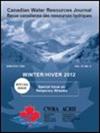太空自动地表水探测:加拿大范围内的开源、自动化、近乎实时的解决方案
IF 0.9
4区 环境科学与生态学
Q3 WATER RESOURCES
引用次数: 2
摘要
摘要本研究的目标是开发一种全自动的方法来绘制开放水域范围,该方法在全国范围内具有操作实用性。这种系统需要在全国所有地区产生可接受的结果,特别是在大草原洞穴地区,在那里,了解水面动力学对于预测洪水、农业/水的可用性和天气模型中的蒸发计算很重要。开发了一个系统来自动化、摄取和处理雷达卫星2号(RS2)图像,使用机器学习分类技术从中近实时绘制开放水体范围。使用从全球地表水(GSW)发生数据集中提取的数据来训练随机森林分类算法。检查了用于提取训练数据的GSW发生阈值,不确定性对分类的影响很小。从RS2精细广角模式图像生成的分类质量随着入射角的增加而提高。所有Fine Quad入射角都产生了可接受的结果,但标准模式和宽模式图像产生的结果低于该操作解决方案可接受的精度阈值。验证是通过将绘制的水域范围与时间重合的高分辨率多光谱图像和美国地质调查局全球土地覆盖特征数据集进行比较来进行的,该数据集目前被ECCC用作天气数值天气建模中的陆地-水域掩模。已经开发的系统将允许使用新的图像数据集(例如雷达卫星星座任务)或训练数据来改进模型。开源代码将在Github上提供。本文章由计算机程序翻译,如有差异,请以英文原文为准。
Automated surface water detection from space: a Canada-wide, open-source, automated, near-real time solution
Abstract The goal of this research was to develop a fully automated method to map open water extent that is operationally practical on a national scale. Such a system needs to produce acceptable results in all regions of the country and particularly in the Prairie Potholes Region where understanding water surface dynamics is important for predicting flooding, agriculture/water availability and for evaporation calculations in weather models. A system was developed to automate, ingest, and process Radarsat-2 (RS2) imagery, from which mapping open water body extents in near-real time was carried out using a machine learning classification technique. A Random Forest classification algorithm was trained using the data extracted from the Global Surface Water (GSW) occurrence dataset. The GSW occurrence thresholds used to extract the training data were examined and there was little influence of uncertainty on the classification. The quality of classifications generated from RS2 Fine Wide mode imagery improved with increasing incidence angle. All Fine Quad incident angles produced acceptable results, but Standard and Wide mode imagery produced results below the accuracy thresholds deemed acceptable for this operational solution. Validation was carried out by comparing mapped water extents to temporally coincident high resolution multi-spectral imagery and to the USGS Global Land Cover Characteristics dataset, that is currently used as a land-water mask by ECCC in weather numerical weather modelling. The system that has been developed will allow new image datasets (e.g. Radarsat Constellation Mission) or training data that becomes available to be used to improve models. The open source code will be made available on Github.
求助全文
通过发布文献求助,成功后即可免费获取论文全文。
去求助
来源期刊

Canadian Water Resources Journal
WATER RESOURCES-
CiteScore
2.90
自引率
5.90%
发文量
17
审稿时长
>12 weeks
期刊介绍:
The Canadian Water Resources Journal accepts manuscripts in English or French and publishes abstracts in both official languages. Preference is given to manuscripts focusing on science and policy aspects of Canadian water management. Specifically, manuscripts should stimulate public awareness and understanding of Canada''s water resources, encourage recognition of the high priority of water as a resource, and provide new or increased knowledge on some aspect of Canada''s water.
The Canadian Water Resources Journal was first published in the fall of 1976 and it has grown in stature to be recognized as a quality and important publication in the water resources field.
 求助内容:
求助内容: 应助结果提醒方式:
应助结果提醒方式:


